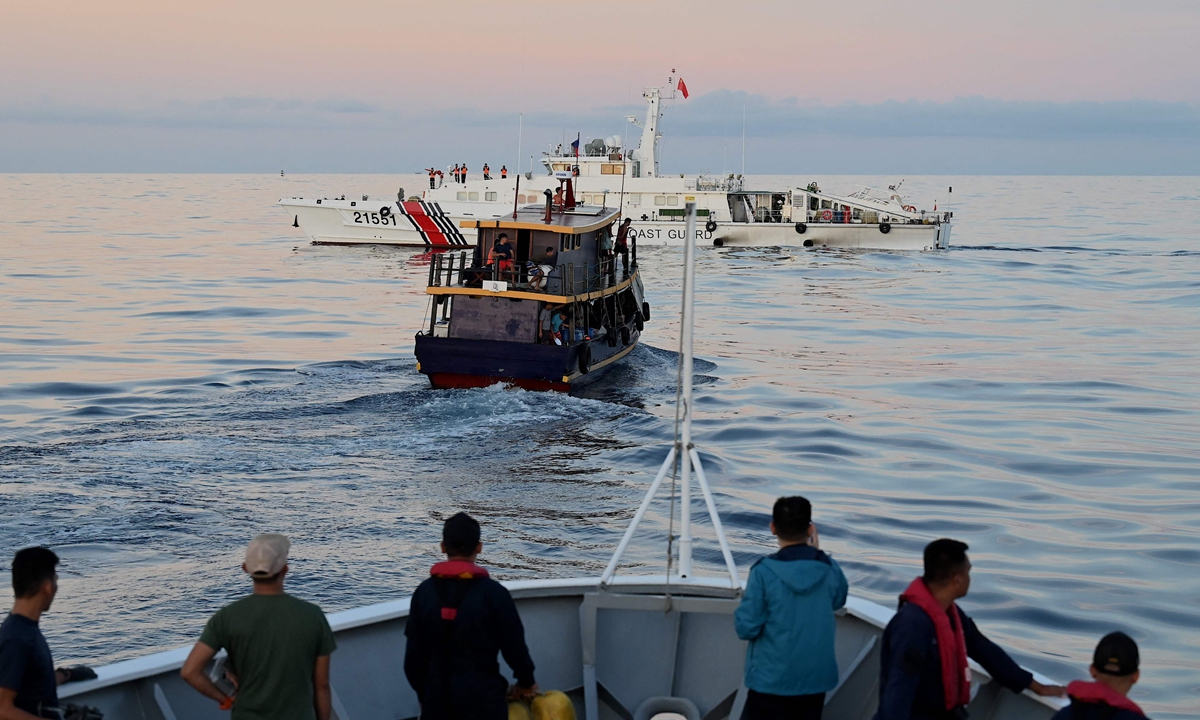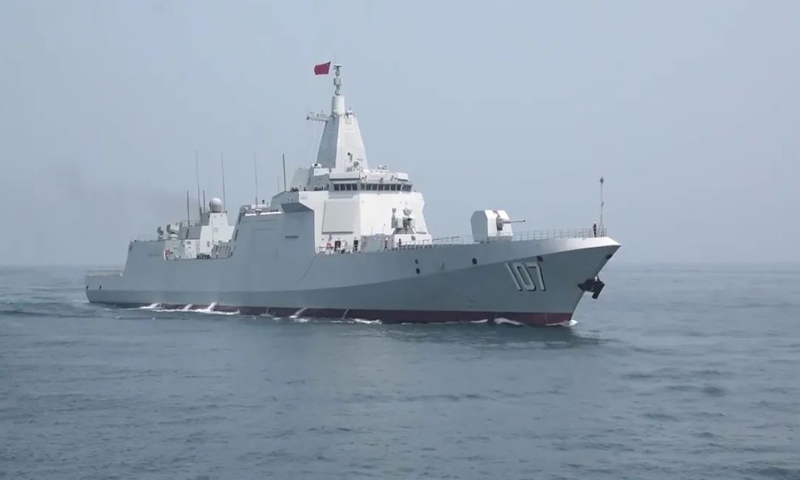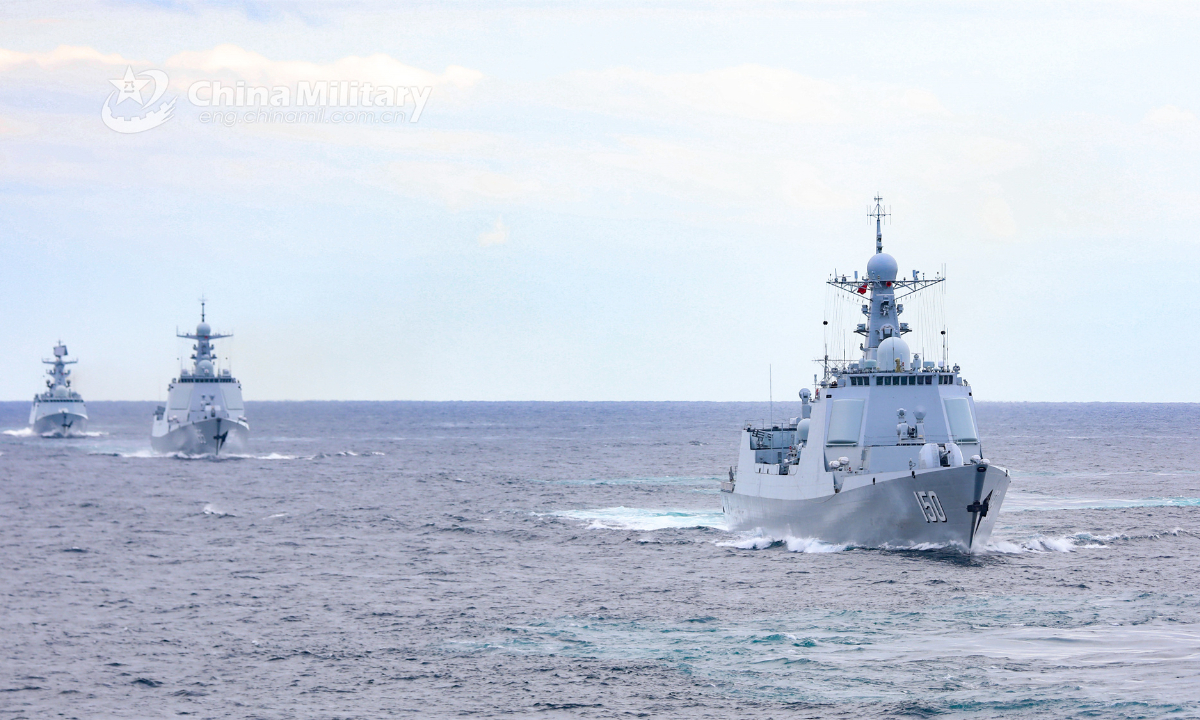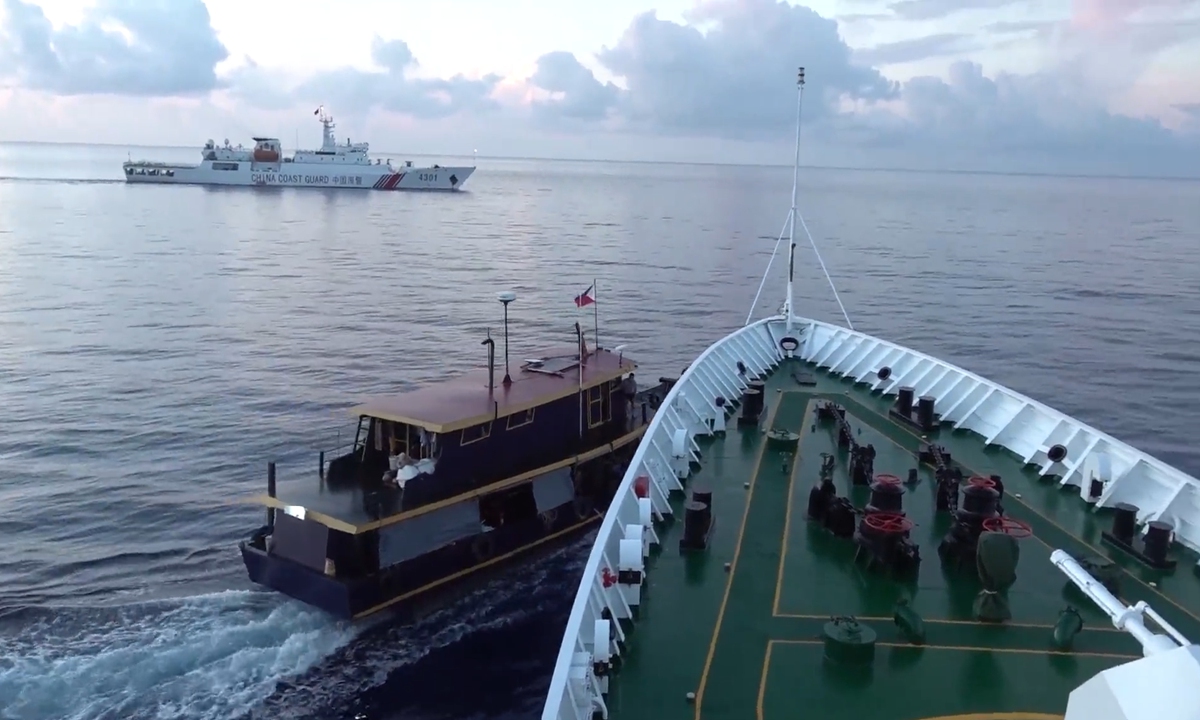IN-DEPTH / IN-DEPTH
GT investigates: Unveiling propaganda campaign by Philippines, Western media to defame China, stir up trouble in South China Sea

China urges some Philippines ships to immediately cease its infringing actions on November 10, 2023. Two small Philippine transport ships and three Philippine Coast Guard ships illegally entered the area on that day without China's permission. Photo: Visual News
In recent months, the Philippines has repeatedly intruded on the waters near China's Huangyan Island and Ren'ai Jiao (Ren'ai Reef) in the South China Sea, while simultaneously spreading false information and even staging incidents in the international public opinion arena, specifically aimed at defaming China to exacerbate tensions with neighboring countries. Many Western media outlets, ravenously feasting on the opportunity to discredit China, have also joined forces with the Philippines to distort the facts.
Why does the Philippines, despite knowing the potential for conflict, choose to provoke and manipulate journalists to create a provocative narrative against China? What are their attempts to control public opinion? What are the different motivations and sinister intentions behind the different parties involved?
Through investigation and verification, the Global Times has discovered a resonance between the Philippines and some Western media in the production of fake news on the South China Sea issue, as they attempt to converge and create a false narrative that portrays China as aggressive, domineering and a bullying to smaller nations. Such deliberate efforts to create confusion will not help resolve the South China Sea issue, but instead damage peace and stability in the region.
Escalated farce
"Territorial conflict,""risky intercepts," and "extremely reckless and dangerous harassment" are a few of the high-frequency keywords that have emerged in recent reports by major Philippine media outlets regarding China's justified actions in the South China Sea, an indication of an intensifying false propaganda offensive by the Philippines.
The Philippine government has extensively laid the groundwork to aid in swaying public opinion, including creating conflicts in disputed waters through the use of various "props" and launching strong premeditated counterattacks.
The most iconic bit of fake news material from the Philippine propaganda campaign in the South China Sea comes from their "grounded" vessel at Ren'ai Jiao. Ren'ai Jiao is part of China's Nansha Island. However, the Philippines has "grounded" a military vessel at Ren'ai Jiao and attempted to repair and reinforce it in an attempt to permanently occupy the area. Using this "grounded" vessel, the Philippines has orchestrated a series of combined public opinion offensives.
The corpse-like vessel has become an important tool for Philippine authorities and anti-China media to agitate constant waves in the South China Sea.
On October 22, the Philippines once again attempted to supply construction materials to the grounded vessel at Ren'ai Jiao and were intercepted by the China Coast Guard (CCG). Surprisingly, they then approached the CCG patrol ship, resulting in two consecutive collisions between the two vessels.
Following this incident, the Philippines began a series of propaganda attacks. The Philippine Presidential Communications Office publicly stated on Facebook that Philippine President Ferdinand Romualdez Marcos had convened a special command conference of the national security and defense clusters to "look into China's recent harassment."
Jonathan Malaya, spokesperson for the national security council of the country, then accused China of "increasing tensions" in the South China Sea during a press conference.
However, the Global Times found that behind the scenes of these South China Sea disputes, there are always Philippine government officials who incentivize confrontations by providing free oil and groceries, inciting Filipino fishermen to challenge China's control zone, provoking CCG patrol ship, and staging incidents for the camera. They also conduct close-range reconnaissance of the CCG's on-site control facilities such as the barrier nets, and seize opportunities to sabotage them.
Unable to base any of the narratives peddled on fact, the Philippine side has resorted to employing anything related to maritime activities as evidence, including maritime buoys and ship anchors.
On September 25, the Philippine Coast Guard (PCG) carried out a "special operation," disguised as ordinary fishermen by approaching the Huangyan Island and then submerging to cut some floats anchored in the ocean. Subsequently, the PCG held a press conference, releasing a video showcasing their "valiant action" and presenting an unidentified iron anchor as "captured equipment," while boasting about their successful "interception of China."
The video in question clearly shows signs of the scene being staged, with obvious adjustments of angles during underwater filming, deliberately avoiding any crucial actions and visuals that could reveal the buoy's information. Chinese netizens have shared comparison photos, pointing out that the so-called iron anchor of the Chinese Navy, as claimed by the PCG, is actually a common tool used by Chinese fishermen.
Observers have pointed out that the interception by the CCG is legitimate and necessary. China has set up floating barriers at the entrance of the lagoon within Huangyan Island to safeguard its sovereignty, and there is no element of "bullying" involved.
And when there is no any "evidence," the Philippines attempts to escalate tensions in the South China Sea and furthers attempts at playing the innocent bullying victim card in the issue.
On August, disregarding China's repeated dissuasion and warnings, the Philippines dispatched two vessels to illegally enter Ren'ai Jiao territory, in an alleged attempting at delivering construction materials to "grounded" vessels. The PCG fabricated a story using static photos on Facebook, claiming that the CCG had engaged in "dangerous maneuvers and illegal use of water cannons against the PCG vessels."
However, in the footage released by the CCG, the Chinese vessel's water column did not hit the supply ship and instead went into the sea.
On August 7, CCG spokesperson Gan Yu clearly stated in a press conference that the CCG vessel carried out a lawful interception and employed warning enforcement measures. "In the face of ineffective warnings after multiple calls, in order to avoid direct interception and collision, water cannons were used as further deterrence. The on-site operation was professional, restrained, and beyond reproach."
The irony is, despite all the cries of "justice," no Filipino media outlet has ever mentioned the CCG's restraint when intercepting Filipino fishing boats. They also deliberately ignored the fact that the Chinese navy frequently conducts rescue operations to assist Filipino fishermen in the waters of the South China Sea, and receives sincere gratitude from those who have been rescued.
In addition to the repeated use of the "grounded" vessel, the Philippines has previously hyped up the claim that "China has destroyed coral reefs in the South China Sea" and even threatened to take legal action against China. This move has been strongly condemned by China as a "political farce."
"If the Philippines truly cares about the ecological environment of the South China Sea, it should tow away the illegally 'grounded' warship at Ren'ai Jiao as soon as possible, stop it from discharging polluted water into the ocean, and not let the rusting warship bring irrevocable harm to the ocean," China's Foreign Ministry Spokesperson Mao Ning responded on a routine press conference in September.
From the previous sensational claims about Chinese fishermen digging up coral reefs and damaging the marine environment, to the slanderous claims that the CCG were driving away Filipino fishermen, and recent demands to dismantle the floating barriers placed by China, the Philippine authorities and local media outlets have continuously escalated their propaganda, gradually forming a mature set of arguments by utilizing sporadic public opinion attacks, Peng Nian, a scholar at China's National Institute for South China Sea Studies, told the Global Times.
Peng pointed out that this series of actions indicates a growing possibility of radicalization in the policies and actions of the Philippine government regarding the South China Sea issue.
These recent disputes are actually part of a series of actions taken by the Philippines against China's stance on the South China Sea issue. These include providing supplies to grounded vessels, inviting foreign media outlets to report on the propaganda, and conducting joint patrols with the US, Dai Fan, director of the Center for Philippine Studies at Jinan University, told the Global Times.
"The Philippine government aims to establish an image of China bullying the Philippines in the international community, promote the idea that China is undermining international rules, and at the same time, divert attention from its increasingly acute domestic conflicts to rally public support." Dai noted.

Photo: VCG
Unseemly tricks
Worse still, the US-led West continues to meddle in South China Sea issues so as to attempt to interfere in China's internal affairs and damage China's international image. Some Western media outlets, abandoning their basic principles of professionalism such as balance and objectivity, openly side with the Philippines and attack China with unseemly tricks.
One of the major tricks employed by some Western media outlets in slandering China with regard to their South China Sea-related coverage is only presenting the Philippine narrative.
The Global Times took note of 10 recent stories by mainstream Western media outlets on South China Sea issues, in which only three quoted statement made by the Chinese government and experts. None of the 10 stories contained any first-hand interviews with the Chinese side. In stark contrast, the stories were replete with first-hand quotes from Filipino fishermen, government officials, and experts.
In a September story titled "Filipino fisherman chased by China coast guard in disputed waters," AFP journalists, who openly stated that they had been "on board" a Philippine government ship at that time, detailed Filipino fishermen's sensational claims and the country's officials' incendiary accusations against China.
The story, similar to many others by Western media outlets, turned a blind eye to any response, statements, or explanations from the Chinese side, transforming supposed impartial reporting by an independent third-party media outlet into a de facto press release by the Philippine government, Chinese observers pointed out.
The use of blatantly inflammatory and offensive headlines is yet another cliché trick resorted to by Western media outlets.
A Bloomberg article titled "Philippines Steps Up Exposure of China 'Bullying' in Sea Row" published in August as well as a Chinese-language article published by the VOA-titled "Water cannon incident escalates tensions in the South China Sea; international community condemns Beijing's 'dangerous' move" are just two such examples. Headlines like these paint China in a negative light, setting a negative tone in reporting by media outfits expected to be professional and impartial.
In the multimedia era, some journalists from Western media outlets, together with their Filipino peers, livestream on China's legitimate expulsions of the Philippine ships, in an attempt to create "panic" among countries and regions in the South China Sea, warned Chinese experts.
"That has put pressure on our law enforcement in the South China Sea," said Ma Bo, a scholar at the Collaborative Innovation Center for South China Sea Studies, Nanjing University.
Since the Marcos Jr administration came to power, especially after signing the Enhanced Defense Cooperation Agreement with the US early this year, the Philippines has been standing with the US-led West in tarnishing China's image on South China Sea issues, said Ma. "Their tactics include, but are not limited to, public opinion warfare targeting China," he told the Global Times.
Unforeseen consequences
Currently, the Philippines' provocative actions on China's territory in the South China Sea, coupled with the rampant fabrication of false information, have created a certain political resonance with the Western media. Observers pointed out that such collaboration satisfies the selfish desires of some politicians, while deceiving people domestically and internationally to the detriment of regional peace.
The Philippines has become increasingly aggressive, testing China's limits and assessing the US' commitment as its ally, noted Ma.
Following recent incidents of provocation, the US and Japan have been prompt to express their support for the Philippines in diplomatic terms.
"While the US is not a directly involved party in the South China Sea issue, it has been meddling in the matter, using the disputes between China and the Philippines over Ren'ai Jiao, and even the South China Sea, as a means to contain China," Ma said.
Recently, the US' Diplomat magazine reported on the collision between Chinese and Philippine vessels near a disputed shoal in October. It asserted that given China's increasingly confident demeanor, a real conflict was only a matter of time. However, the reality is that it is the Philippines and its deep-rooted alliance with the US that has irresponsibly and irrationally provoked conflicts, and deliberately put on a show for the media, Dai said.
Observers point out that the rampant spread of purposeful fake news not only impacts the China-Philippines relationship but also hinders the negotiation of the Code of Conduct (COC) in the South China Sea, as well as undermines the continuity and strengthening of China's strategic mutual trust with the ASEAN. At the same time, once fake news stirs up nationalist sentiments within the Philippines, it will also be of great detriment for the country.
Such propaganda theatrics are likely to continue between the Philippines and some Western media, but we hope that the Philippines will reconsider its stance and exercise restraint, making a genuine choice to promote a peaceful resolution to the South China Sea issue, Ma said.



